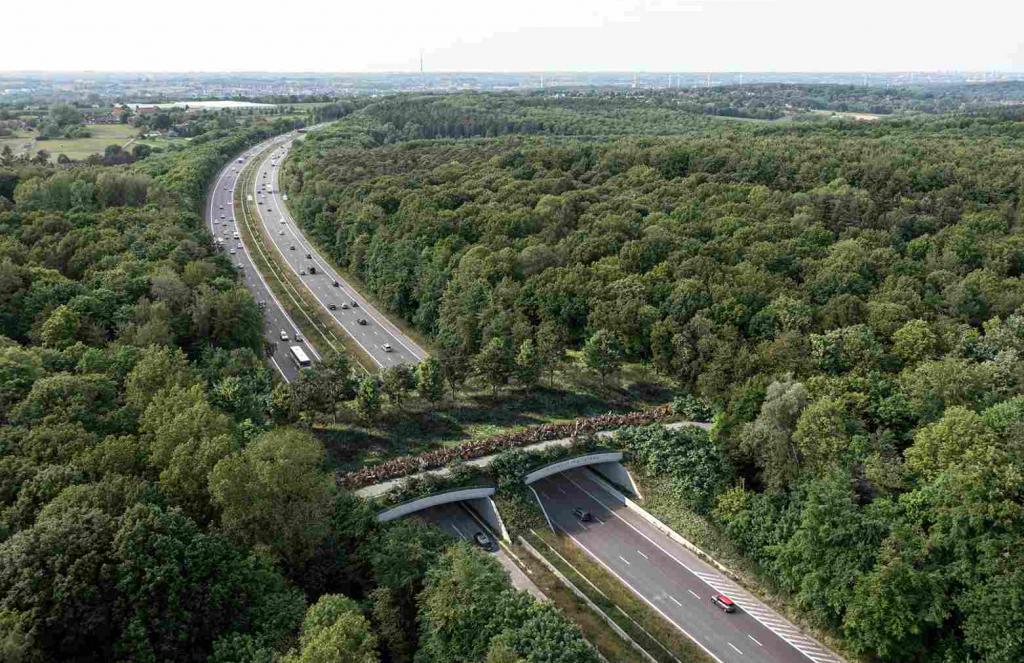Thessaloniki gets ready for its metro launch in November
The underground rapid transit lines have been under construction for almost two decades due to various project delays
 TheMayor.EU logo
TheMayor.EU logo 
The green bridge will be 65 metres long, with only 5 oven to people, Source: Agentschap Wegen en Verkeer (Roads and Traffic Agency in Fladners)
The Brussels Ring highway has split the forest in two, shrinking natural habitats and separating species
Yesterday, regional authorities in Belgium announced that they will construct an ecoduct – a green connection between the two sections of the Hallerbos forest near Brussels. The connection should help both animals to travel freely in the forest, which is now cut by the Brussels ring – a metropolitan highway.
The project has just been approved by the Flemish government as the construction site is outside of the Brussels Capital Region. Construction is set to start in 2023 with the end date estimated in 2025.
Barriers are one of the most important factors in nature: rivers, mountains and seas can serve as hard stops for any species to move to a given location. Increasingly, humans are contributing to the division of non-urbanised land, as our roads and suburban sprawl creep into shrinking habitats.
Highways are one such barrier, with fences and multiple crowded lanes, they can split the population of a biome very drastically, separating animals from food sources. According to a study in the Hallerbos (a big natural reserve and forest at the edge of Brussels), this is exactly what is happening.
The study was conducted by the Flemish Environment Department and it showed that there are 275 animals of various species in the forest. However, the populations on both sides of the forest, split by the Brussels Ring, were radically different.
The ecoduct aims to create more opportunities for both sides to link naturally and strengthen local biodiversity, also increasing the habitat of the animals.
The new design for the bridge will be 65 metres wide, to offer enough space for all that want to cross, both pedestrians and animals. However, only five metres from the site will be dedicated to ‘human’ infrastructure, with a pedestrian and cycling lane.
Animals will have free reign over the other 60 metres, enough space to let them cross without any fear. The earthen walls of the highway are three metres tall and the bridge will be at that elevated position, to allow a smooth transition. Additionally, the trees that need to be felled to make way for the construction, will gain a new lease on life as part of the barrier between the human infrastructure and the rest of the ecoduct.

The underground rapid transit lines have been under construction for almost two decades due to various project delays

Now you can get your wine in Talence by paying directly in Bitcoin

That’s because the state has to spend money on updating the railway infrastructure rather than subsidizing the cost of the popular pass

Rethinking renewable energy sources for the urban landscape

The examples, compiled by Beyond Fossil Fuels, can inform and inspire communities and entrepreneurs that still feel trepidation at the prospect of energy transition

Now you can get your wine in Talence by paying directly in Bitcoin

The 10th European Conference on Sustainable Cities and Towns (ESCT) sets the stage for stronger cooperation between the EU, national and local level to fast track Europe's transition to climate neutrality.

At least, that’s the promise made by the mayor of Paris, Anne Hidalgo

The underground rapid transit lines have been under construction for almost two decades due to various project delays

At least, that’s the promise made by the mayor of Paris, Anne Hidalgo

Hostal de Pinós is located in the geographical centre of the autonomous region

Despite its church-y name, the district has long been known as the hangout spot for the artsy crowds

Urban dwellers across the EU are having a say in making their surroundings friendlier to people and the environment.

Forests in the EU can help green the European construction industry and bolster a continent-wide push for architectural improvements.

Apply by 10 November and do your part for the transformation of European public spaces

An interview with the Mayor of a Polish city that seeks to reinvent itself

An interview with the newly elected ICLEI President and Mayor of Malmö

A conversation with the Mayor of Lisbon about the spirit and dimensions of innovation present in the Portuguese capital














